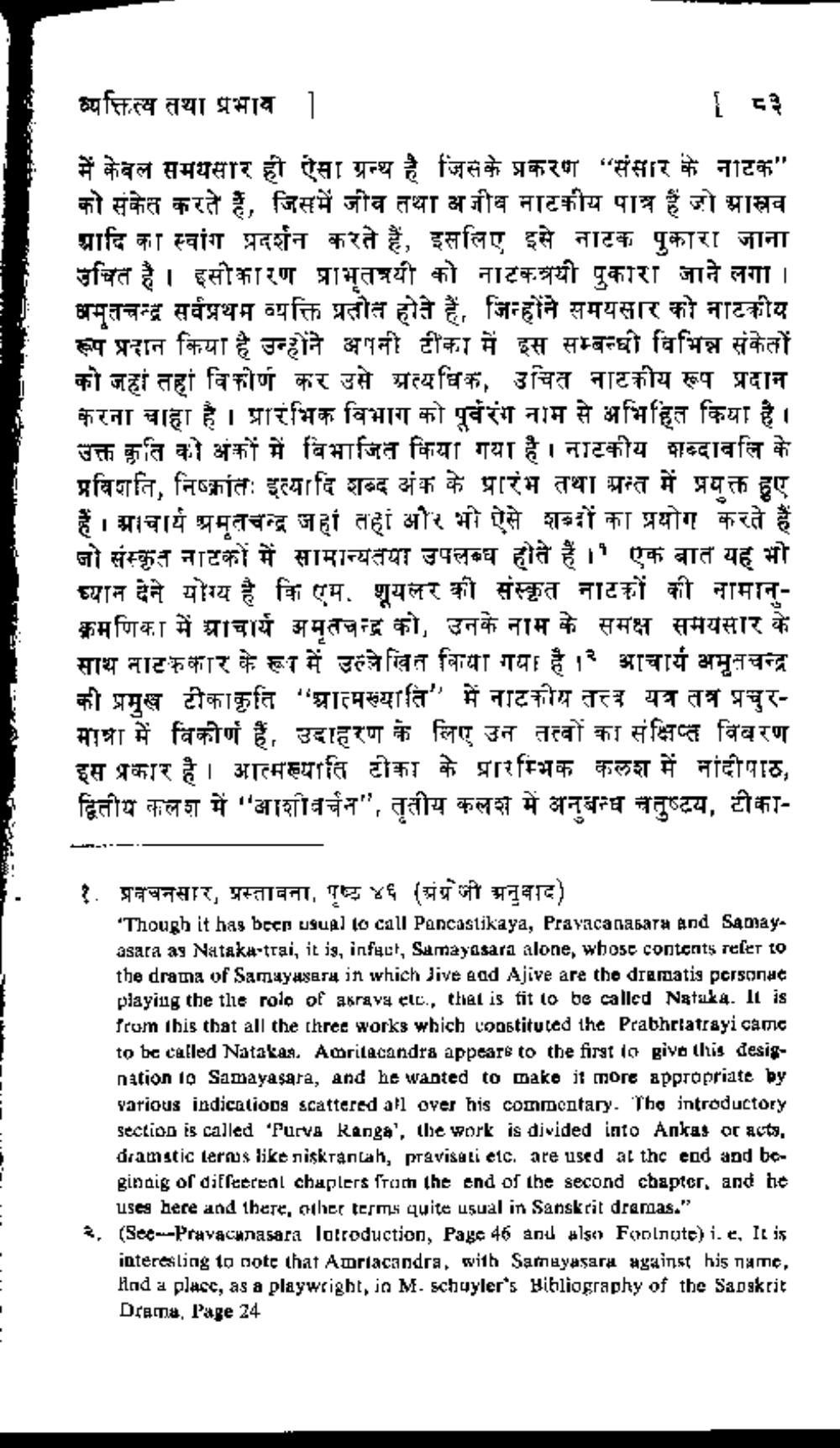________________
व्यक्तित्व तथा प्रभाव ]
में केवल समयसार ही ऐसा ग्रन्थ है जिसके प्रकरण “संसार के नाटक" को संकेत करते हैं, जिसमें जीव तथा अजीव नाटकीय पात्र हैं जो मानव आदि का स्वांग प्रदर्शन करते हैं, इसलिए इसे नाटक पुकारा जाना उचित है। इसी कारण प्राभतत्रयी को नाटक नयी पुकारा जाने लगा। अमृतचन्द्र सर्वप्रथम व्यक्ति प्रतीत होते हैं, जिन्होंने समयसार को नाटकीय रूप प्रदान किया है उन्होंने अपनी टीका में इस सम्बन्धी विभिन्न संकेतों को जहां तहां विकोण कर उसे अत्यधिक, उचित नाटकीय रूप प्रदान करना चाहा है। प्रारंभिक विभाग को पूर्वरंग नाम से अभिहित किया है। उक्त कृति को अंकों में विभाजित किया गया है। नाटकीय बाब्दावलि के प्रविशति, निष्क्रांतः इत्यादि शब्द अंक के प्रारंभ तथा अन्त में प्रयुक्त हुए हैं । प्राचार्य अमृतचन्द्र जहां तहां और भी ऐसे शब्दों का प्रयोग करते हैं जो संस्कृत नाटकों में सामान्यतया उपलब्ध होते हैं। एक बात यह भी ध्यान देने योग्य है कि एम. शूयलर की संस्कृत नाटकों की नामानक्रमणिका में प्राचार्य अमृतचन्द्र को, उनके नाम के समक्ष समयसार के साथ नाटककार के रूप में उल्लेखित किया गया है ।२ आचार्य अमृतचन्द्र की प्रमुख टीका कृति "प्रात्मख्याति' में नाटकीय तत्त्व यत्र तत्र प्रचुरमात्रा में विकीर्ण हैं, उदाहरण के लिए उन तत्वों का संक्षिप्त विवरण इस प्रकार है। आत्मख्याति टीका के प्रारम्भिक कलश में नांदीपाठ, द्वितीय कलश में "आशीवर्चन", तृतीय कलश में अनुबन्ध चतुष्टय, टीका
१. प्रवचनसार, प्रस्तावना, पृष्ट ४६ (अंग्रेजी अनुवाद)
'Though it has been usual to call Pancastikaya, Pravacanasara and Samayasara as Nataka-trai, it is, in fact, Samayasara alone, whose contcats refer to the drama of Samayasara in which live ead Ajive are thedramatis personae playing the the role of akrave etc., that is fit to be called Nataka. It is from this that all the three works which constituted the Prabhrlatrayi came to be called Natakas. Amritacandra appears to the first to give this desisnation 10 Samayasara, and he wanted to make it more appropriate by various indications scattered all over his commentary. The introductory section is called "Furva Ranga', thework isdivided into Ankas or acts, dramatic terms like niskrantah, pravisati etc. are used at the end and beginaig of different chaplers from the end of the second chapter, and he uses here and there, other terms quite usual in Sanskrit dramas." (Sec-Pravacanasara latroduction, Pay:46 and also Fontinute) i.e. It is interesting to note that Amriacandra, with Samayasara against his name, Had a place, as a playwright, in M. schuyler's Bibliography of the Sanskrit Drama, Page 24




